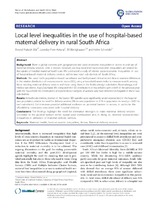Local level inequalities in the use of hospital-based maternal delivery in rural South Africa
Date
2014Author
Silal, Sheetal
Penn-Kekana, Loveday
Barnighausen, Till
Schneider, Helen
Metadata
Show full item recordAbstract
BACKGROUND: There is global concern with geographical and socio-economic inequalities in access to and use of maternal delivery services. Little is known, however, on how local-level socio-economic inequalities are related to the uptake of needed maternal health care. We conducted a study of relative socio-economic inequalities in use of hospital-based maternal delivery services within two rural sub-districts of South Africa. METHODS: We used both population-based surveillance and facility-based clinical record data to examine differences
in the relative distribution of socio-economic status (SES), using a household assets index to measure wealth, among those needing maternal delivery services and those using them in the Bushbuckridge sub-district, Mpumalanga, and
Hlabisa sub-district, Kwa-Zulu Natal. We compared the SES distributions in households with a birth in the previous year with the household SES distributions of representative samples of women who had delivered in hospitals in these two
sub-districts. RESULTS: In both sub-districts, women in the lowest SES quintile were significantly under-represented in the hospital user population, relative to need for delivery services (8% in user population vs 21% in population in need; p < 0.001 in each sub-district). Exit interviews provided additional evidence on potential barriers to access, in particular the affordability constraints associated with hospital delivery. CONCLUSIONS: The findings highlight the need for alternative strategies to make maternal delivery services accessible to the poorest women within overall poor communities and, in doing so, decrease socioeconomic inequalities in utilisation of maternal delivery services. Keywords: Maternal health, Socio-economic inequalities, Access, Maternal delivery services

